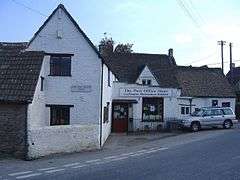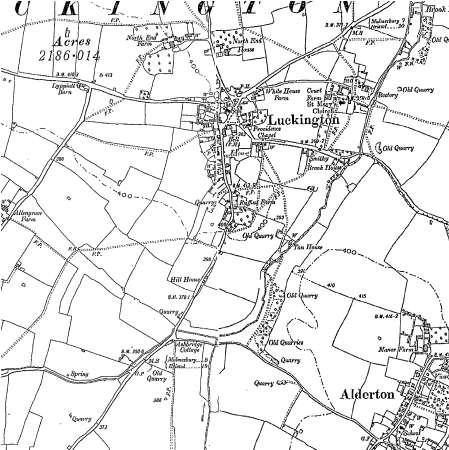Luckington
| Luckington | |
|---|---|
 Post office, Luckington | |
 Luckington | |
| Luckington shown within Wiltshire | |
| Population | 630 (in 2011)[1] |
| OS grid reference | ST833839 |
| Civil parish |
|
| Unitary authority | |
| Ceremonial county | |
| Region | |
| Country | England |
| Sovereign state | United Kingdom |
| Post town | Chippenham |
| Postcode district | SN14 |
| Dialling code | 01666 |
| Police | Wiltshire |
| Fire | Dorset and Wiltshire |
| Ambulance | South Western |
| EU Parliament | South West England |
| UK Parliament | |
| Website | Luckington & Alderton Parish Council |
Luckington is a village in the southern Cotswolds, located in north-west Wiltshire, England, 7 miles (11 km) west of Malmesbury. It is on the B4040 road linking Malmesbury and Old Sodbury.
Luckington in the Cotswolds
The Cotswolds are designated as an Area of Outstanding Natural Beauty (AONB) which means it is recognised as containing some of Britain's finest countryside. As such it is protected as a special landscape of national importance. The area covers 790 square miles, of which some 80% is farmland.
The region is delineated by the belt of rich limestone – the source of building materials for cottages, fine buildings and churches. The limestone Cotswold stone in the northern Cotswolds is a rich honey coloured brown which gradually grades creamier towards the south at Luckington.
Sources of the Avon
In a valley to the south of the village, seasonal springs are the source of the Bristol Avon. The Avon, from Luckington, passes through Malmesbury and Chippenham towards Bath and Bristol. The 17th century writer John Aubrey was probably referring to one of these springs when he wrote: ‘In this village is a fine spring called Hancock’s-well… It cures the itch and Scabbe; it hath done much good to the eies,' writes Aubrey, and again the editor Jackson adds: 'Hancock’s well is still resorted to for the cure of sick dogs, bad legs and the like'.[2] J H P Pafford et al[3] tells us that at the time of writing the well still had the reputation of being good for the eyes. Hancock’s well still flows strongly in its stone culvert down to the river close by.
Historical maps

- Ordnance Survey map from 1817-1830

- Ordnance Survey map from 1899-1901
Luckington Court

Luckington Court, close to the parish church, dates from the 16th century and is a Grade II* listed building.[4]
Both the interiors and exterior were used to represent Longbourn, the Bennet family home, in the BBC's 1995 TV series Pride and Prejudice.
(See also "Notable people" below.)
Village life
Luckington has a community school[5] with fewer than fifty pupils taught by three full-time teachers and two teaching assistants. There is a children's playground located on Church Road near the Green, run as a charitable organisation.[6] There are good playing fields (one soccer pitch) and a village hall, each run by committees.
The farms which surround Luckington are both dairy and arable; some are owned by the Badminton Estate. The Duke of Beaufort's Hunt and the proximity of Badminton have a bearing on village culture. Luckington holds its own fête each year, usually early in July.
There is a Methodist church at Church Road, a 'Tin Tabernacle' built to satisfy the needs of the religious revivals of the 19th century.[7]
The Old Royal Ship Inn[8] is a popular village pub with walkers and cyclists, and the Beaufort Hunt[9] meets there occasionally.
Notable people
- Sir Stewart Menzies was Chief of MI6 (SIS) during and after the Second World War, and on whom Ian Fleming based "M" of James Bond fame. In the 1920s he acquired Bridges Court, an 18th century Grade II listed Cotswold stone farmhouse, set in 30 acres adjoining the Badminton Estate. As a Major-General, he was President of the Luckington branch of the British Legion and took the march past of the Army Cadet Force at a ceremony in April 1948.[10] After the war he retired and died in London in 1968. Bridges Court is now a bed & breakfast hotel.[11]
- Guy N Vansittart, younger brother of diplomat Robert Vansittart, 1st Baron Vansittart, was a director of General Motors Ltd on the continent and managed their HQ in London from 1938. He lived at Luckington Court in the 1940s, and was recruited into "Z” Network and the SOE, headed by Claude Dansey. The Z organisation was supposed to operate independently of British embassies and thus avoid the attention of foreign internal security agencies. He moved to London post-war, continuing his career with General Motors and died in 1989.[12]
- Captain F. W. Hartman, together with his wife Dorothy (the former Lady Dalrymple), lived in Luckington Manor between 1939 and 1952. Dorothy also owned Home Farm Pinkney and Cowage Farm Foxley around the same time. They were directors of Lendrum & Hartman Limited, London, sole concessionaires of imported Buick and Cadillac cars from North America. They supplied King Edward VIII with a custom built Buick in 1936, which was transported with him by warship to France on his abdication. Captain Hartman died in September 1942. They were close business friends of Guy Vansittart. His widow continued running the company, and in 1953 moved to London and Stumblehole Farm in Surrey.[13]
- Captain Robert Treeck, a Baron and German agent, born in Latvia, who escaped during the October Revolution. He was possibly a member of the pre-war dissident group Schwarze Kapelle. Together with his Chilean mistress, Baroness Violetta Schroeders, he leased Luckington Manor in 1936.[14] The Manor is immediately adjacent to Menzies' house, Bridges Court. He joined the Duke of Beaufort's Hunt, to which Menzies already belonged, and paid a handsome £150 into the hunt's funds for the 1937/8 season. Treeck relinquished the lease at the end of the 1938/39 hunt season, and Captain Hartman (see above) took over the lease. Treeck lived a parallel life, as his main country residence was Guilsborough House in Northamptonshire, also leased, where he entertained lavishly and rode with the Pytchley Hunt. In September 1939, Treeck vanished, and Guilsborough and its contents were placed under the control of the Custodian of Enemy Property.
- Actor John Thaw and his wife the actress Sheila Hancock bought a 17th century house in Church Road in 1990, ...or Lucky, as we called it, a Wiltshire village. John loved it, he hid away in it, curling up and shutting the world out.[15] They lived there on a semi-permanent basis until Thaw’s death in 2002. Hancock writes in her book, My life with John Thaw: Today at the Post Office two photographers started snapping at us. John was feeling peaky and just sighed but I was like a wild animal. Luckington has never seen such an unseemly display.[16]
- Basil Harwood, English organist and composer, born in Gloucestershire, was inspired by Luckington when writing the hymn tune of that name, often used for Let all the world in every corner sing, my God and King! The heavens are not too high, his praise may thither fly. This tune features on the album "100 Best Hymns" by the York Minster Choir and is regularly aired on the BBC television programme Songs of Praise.
Church of St Mary and St Ethelbert
The grade I listed parish church is dedicated to St. Mary and St. Ethelbert and is thought to date from the 12th century.[17][18]
In April 1948 the Standard of the British Legion was dedicated by the Dean of Bristol, the Very Rev. Harry Blackburne; the Dean was assisted by Capt. G. F . Farr R.N.(Ret.), Rector of Luckington. The parade was led by D Company, Army Cadet Force and the march past taken by Major General Stewart Menzies, a local resident.[19]
Other listed buildings
Nearly half the buildings in the Luckington parish are grade II listed buildings.
These include the Old Bakehouse , the Forge House , Manor Farmhouse in Alderton, Whitehouse Farmhouse, Witches Cottage,[20] North End House , Wick Farmhouse, the Old Rectory, Luckington Court, Luckington Manor, Lypiatt Barn and the Post Office Stores .
Books and further reading
- Wiltshire Villages (The Village series) by Brian J. Woodruffe, Robert Hale Ltd, 1982, ISBN 0709197454 / 0-7091-9745-4
- Aubrey's Natural History of Wiltshire, John Aubrey, David and Charles Reprints, 1969, ISBN 0715346709
- Wiltshire: Cradle of our Civilisation, Arthur Mee, Hodder and Stoughton, 1939
- The Dovecots and Pigeon Lofts of Wiltshire, John and Pamela McCann, Hobnob Press, 2011, ISBN 978 0 946418 84 8
- The imperial gazetteer of England and Wales embracing recent changes in counties dioceses parishes and boroughs general statistics postal arrangements railway systems &c. and forming a complete description of the country, John M. Wilson, 1870,
- The topographical collections of John Aubrey, 1659–70: Corrected and enlarged by John Edward Jackson, Longman & Co., London 1862
- Collectanea, Wiltshire Archaeological and Natural History Society, Records Branch Volume XII; Williams, N J (editor), Wiltshire Archaeological and Natural History Society, Records Branch, Devizes, 1956
- The Two of Us: My Life with John Thaw, Sheila Hancock, Bloomsbury Publishing, 2005, ISBN 9780747577096
- Just Me, Sheila Hancock, Bloomsbury Publishing Plc, 2009
- C: The Secret Life of Sir Stewart Menzies, Spymaster to Winston Churchill, Anthony Cave Brown, Macmillan, 1987
- The Unseen War in Europe: Espionage and Conspiracy in the Second World War, John H. Waller, I B Tauis & Co., London 1996
- Hitler's Spy Chief, Richard Bassett, Orion Publishing 2005
References
- ↑ "Wiltshire Community History – Census". Wiltshire Council. Retrieved 28 February 2015.
- ↑ Aubrey 1862, pp.105–106
- ↑ Collectanea, 1953, p.29
- ↑ Historic England. "Luckington Court (1022373)". National Heritage List for England. Retrieved 28 February 2015.
- ↑ http://www.luckingtonschool.co.uk/
- ↑ https://www.facebook.com/luckingtonplayground/timeline?filter=2
- ↑ "Primitive Methodist Chapel, Luckington". Wiltshire Community History. Wiltshire Council. Retrieved 28 February 2015.
- ↑ http://www.thegoodpubguide.co.uk/pub/view/Old-Royal-Ship-SN14-6PA
- ↑ http://www.beauforthunt.com/
- ↑ Western Daily Press, 19 April 1948
- ↑ http://www.bridgescourt.co.uk/house.html
- ↑ The Vansittart brothers
- ↑ British Telephone books 1880–1984
- ↑ John H. Waller (1996), The Unseen War in Europe: Espionage and Conspiracy in the Second World War, I.B.Tauris, pp. 18–19, ISBN 978-1-86064-092-6
- ↑ http://www.dailymail.co.uk/femail/article-1186849/The-words-helped-survive-death-beloved-John-Thaw-Sheila-Hancock.html
- ↑ The Two of Us: My Life with John Thaw, Sheila Hancock, Bloomsbury Publishing, 2005
- ↑ Historic England. "Church of Saint Mary and Saint Etherlbert, Luckington (1199767)". National Heritage List for England. Retrieved 28 February 2015.
- ↑ "Church of St. Mary and St. Ethelbert, Luckington". Wiltshire Community History. Wiltshire Council. Retrieved 28 February 2015.
- ↑ Western Daily Press, 19 April 1948
- ↑ http://www.britishlistedbuildings.co.uk/en-316059-witches-cottage-luckington-
External links
- "Luckington". Wiltshire Community History. Wiltshire Council. Retrieved 28 February 2015.
![]() Media related to Luckington at Wikimedia Commons
Media related to Luckington at Wikimedia Commons